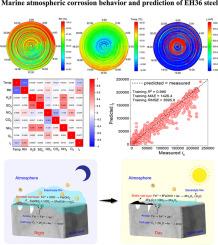海洋大气中EH36钢数据驱动腐蚀行为与预测:腐蚀大数据与机器学习的集成
IF 14.3
1区 材料科学
Q1 MATERIALS SCIENCE, MULTIDISCIPLINARY
引用次数: 0
摘要
海洋工程设备和设施面临着重大的大气腐蚀挑战。腐蚀数据收集和分析技术的局限性阻碍了对海洋钢结构在复杂大气环境条件下腐蚀行为的全面理解。本研究将腐蚀大数据技术与机器学习方法相结合,研究了相对湿度(RH)、温度和各种污染物等耦合环境因素对EH36钢大气腐蚀行为的影响。腐蚀大数据传感器检测的累积电量曲线表明,EH36钢在6个月(m)暴露期内的腐蚀速率先加速后减速,最后趋于稳定。这一趋势与减重数据一致,证实了腐蚀大数据监测技术的可靠性。相关性分析表明,相对湿度和温度是影响腐蚀的关键因素。较高的相对湿度有助于在EH36钢表面形成电解质膜,加速腐蚀。相反,温度升高会降低相对湿度,导致温度与腐蚀速率呈负相关。这些结果表明,RH是影响EH36钢在海洋大气环境中腐蚀的最主要因素。在此基础上,构造了一种能够处理大气环境参数间非线性关系和相互作用的极限梯度增强(XGB)算法。XGB模型在估算海工钢结构腐蚀速率方面具有较强的预测性能,有助于海工设备设施的安全可靠运行。本文章由计算机程序翻译,如有差异,请以英文原文为准。

Data-driven corrosion behavior and prediction of EH36 steel in marine atmosphere: Integrating corrosion big data with machine learning
Marine engineering equipment and facilities face significant atmospheric corrosion challenges. Limitations in corrosion data collection and analysis techniques have hindered a comprehensive understanding of the corrosion behavior of marine steel structures under complex atmospheric environmental conditions. In this study, corrosion big data technology was integrated with machine learning methods to investigate the influence of coupled environmental factors, such as relative humidity (RH), temperature, and various pollutants, on the atmospheric corrosion behavior of EH36 steel. The curve of cumulative electric quantity detected by the corrosion big data sensor indicated that the corrosion rate of EH36 steel over a 6-month (m) exposure period initially accelerated, then decelerated, and finally stabilized. This trend is consistent with the weight loss data, confirming the reliability of corrosion big data monitoring technology. Correlation analysis identified RH and temperature as the key factors influencing corrosion. Higher RH facilitated the formation of an electrolyte film on the EH36 steel surface, accelerating corrosion. In contrast, increased temperature reduced RH, resulting in a negative correlation between temperature and corrosion rate. These findings suggest that RH is the most dominant factor affecting the EH36 steel corrosion in marine atmospheric environments. Furthermore, an extreme gradient boosting (XGB) algorithm capable of handling nonlinear relationships and interactions among atmospheric environmental parameters was constructed. The XGB model demonstrated strong predictive performance in estimating the corrosion rate of marine steel structures, contributing to the safe and reliable operation of marine engineering equipment and facilities.
求助全文
通过发布文献求助,成功后即可免费获取论文全文。
去求助
来源期刊

Journal of Materials Science & Technology
工程技术-材料科学:综合
CiteScore
20.00
自引率
11.00%
发文量
995
审稿时长
13 days
期刊介绍:
Journal of Materials Science & Technology strives to promote global collaboration in the field of materials science and technology. It primarily publishes original research papers, invited review articles, letters, research notes, and summaries of scientific achievements. The journal covers a wide range of materials science and technology topics, including metallic materials, inorganic nonmetallic materials, and composite materials.
 求助内容:
求助内容: 应助结果提醒方式:
应助结果提醒方式:


